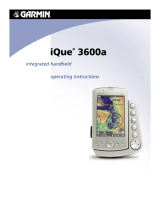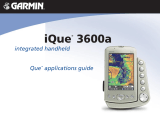
iv iQue
®
3000 Operating Instructions
INTRODUCTION > TABLE OF CONTENTS
Chapter 1: Introduction to the iQue .................1
System Requirements .................................................. 1
iQue Components ........................................................ 2
Starting Your Handheld and Calibrating the Screen ..... 5
Resetting Your iQue ..................................................... 6
Opening Applications ................................................... 7
Using the Handheld Interface ....................................... 8
Using Menus and Menu Commands ............................ 9
Customizing Your Handheld .......................................10
Personalizing Your Handheld ..................................... 10
Setting the Date, Time, and Time Zone ...................... 11
Formatting the Date, Time, and Numbers ..................13
Setting the Sounds and Volumes ...............................15
Palm
™
Desktop Software ............................................16
Chapter 2: Entering Data in Your iQue ..........17
Using the On-Screen Keyboard ................................. 17
Entering Data Using Graffiti
®
2 Handwriting Software 18
Using Graffiti
®
2 Gestures .......................................... 23
Using the Graffiti
®
2 Tuner ..........................................25
Importing Data ............................................................ 26
Chapter 3: Managing Applications ................27
Using the Applications Launcher ................................ 27
Installing Add-On Applications .................................... 31
Assigning Security Options ........................................ 33
Chapter 4: Using Basic Applications .............36
Using the Date Book .................................................. 36
Scheduling Events .....................................................37
Setting Alarms ............................................................43
Working in Week View ............................................... 46
Working in Month View ............................................... 48
Using the Address Book ............................................. 51
Adding and Using Address Book Entries ................... 52
Editing Address Book Entries ..................................... 54
Using the To Do List ................................................... 56
Creating To Do List Items ........................................... 57
Setting To Do List Priorities ........................................ 58
Changing Priorities and Due Dates ............................ 59
Using the Memo Pad .................................................. 61
Using the Calculator ................................................... 63
Chapter 5: Performing Common Tasks .........65
Creating Records ....................................................... 65
Finding Records .........................................................70
Sorting Records .........................................................72
Making Records Private .............................................73
Attaching Notes .......................................................... 75
Chapter 6: Using the Attention Manager .......77
Insistent Alarms .......................................................... 77
Subtle Alarms ............................................................. 80
Chapter 7: Using an Expansion Card ............81
Using Card Info .......................................................... 85
Chapter 8: Beaming Information ....................87
Chapter 9: Exchanging and Updating Data
Using HotSync
®
Operations ...........................89
Performing a HotSync Operation for the First Time ... 89
Selecting HotSync
®
Setup Options ............................ 91
IR HotSync Operations ..............................................93
Conducting a HotSync
®
Operation Via a Modem ....... 96
Conducting a HotSync
®
Operation Via a Network ...... 99
Chapter 10: Setting Connection and Network
Preferences ....................................................101
Connection Preferences ........................................... 101
Network Preferences ................................................ 103
Specifications ........................................................... 110
Software License Agreement ................................... 111
Index ............................................................... 113
TABLE OF CONTENTS


























